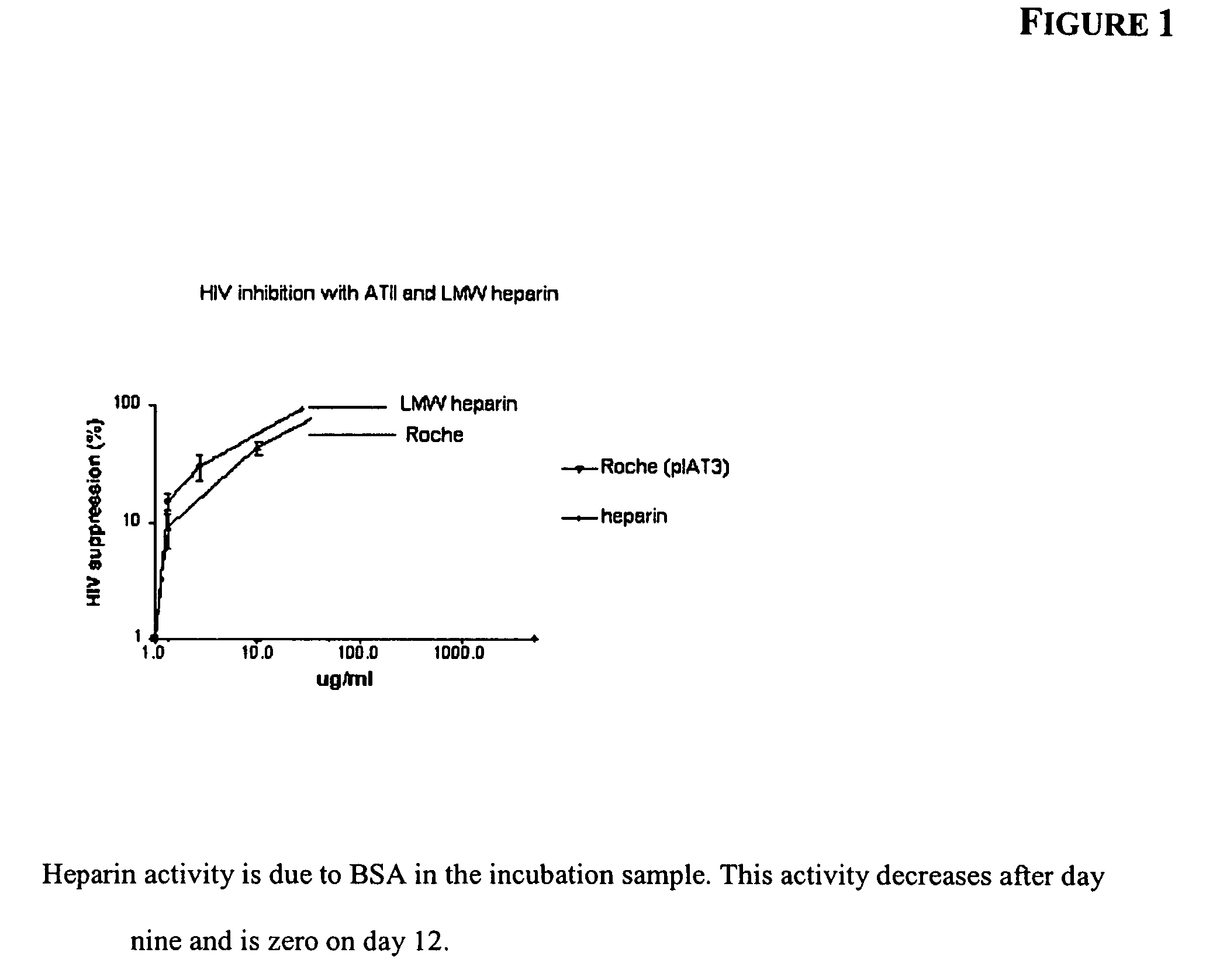Method of reducing viral load
a viral load and load reduction technology, applied in the field of viral load reduction, can solve the problems of not all potential victims are able to receive vaccinations, many at-risk people do not receive or have access to vaccines, and not all viruses can be prevented. , to achieve the effect of shortening the pre-clinical and clinical testing tim
- Summary
- Abstract
- Description
- Claims
- Application Information
AI Technical Summary
Benefits of technology
Problems solved by technology
Method used
Image
Examples
example 1
Preparation Procedures for In Vitro Plasma ATIII Activation Using Standard, Unfractionated Heparin
[0062]Standard, unfractionated heparin for human use (1,000-10,000 units, or about 2 to about 40 mg) was added to 500 mL samples of commercially available human plasma (containing an average of about 120 to about 150 mg of ATIII) in a sterile incubation bag. The amount of heparin added to the bag depends on the viral load of the patient and the treatment regimen desired. The resulting mixture was incubated at room temperature, 37° C. or 40° C., for 24-72 hours. Gentle mixing was applied as necessary during the incubation period. The incubated mixture may be infused into a patient with or without further purification to remove unreacted heparin. In these procedures, the heparin dosage is very low compared to the level of ATIII in the plasma so that free heparin in the resultant mixture is avoided, thus decreasing the risk for bleeding.
example 2
Preparation Procedures for In Vitro Blood ATIII Activation Using Standard, Unfractionated Heparin
[0063]Standard, unfractionated heparin for human use (1,000-20,000 units, or about 2 to about 40 mg) was added to 1,000 mL samples of blood drawn from HIV or HCV patients (containing an average of about 70 to about 150 mg of ATIII) in a sterile incubation bag. The resulting mixture was incubated at room temperature, 37° C. or 40° C., for 24-72 hours. Gentle mixing was applied as necessary during the incubation period. The incubated mixture may be infused into a patient with or without further purification to remove unreacted heparin. In these procedures, the heparin dosage is very low compared to the level of ATIII in the plasma so that free heparin in the resultant mixture is avoided, thus decreasing the risk for bleeding.
example 3
Preparation Procedures for In Vitro Plasma ATIII Activation Using Low Molecular Weight Heparin
[0064]Low molecular weight (LMW) heparin for human use (1,000-10,000 units, or about 2 to about 20 mg) was added to 500 mL samples of commercially available human plasma (containing an average of about 70 to about 150 mg of ATIII) in a sterile incubation bag. The resulting mixture was incubated at room temperature, 37° C. or 40° C., for 24-72 hours. Gentle mixing was applied as necessary during the incubation period. The incubated mixture may be infused into a patient with or without further purification to remove unreacted heparin. In these procedures, the heparin dosage is very low compared to the level of ATIII in the plasma so that free heparin in the resultant mixture is avoided, thus decreasing the risk for bleeding.
PUM
| Property | Measurement | Unit |
|---|---|---|
| molecular weight | aaaaa | aaaaa |
| molecular weight | aaaaa | aaaaa |
| temperature | aaaaa | aaaaa |
Abstract
Description
Claims
Application Information
 Login to View More
Login to View More - R&D
- Intellectual Property
- Life Sciences
- Materials
- Tech Scout
- Unparalleled Data Quality
- Higher Quality Content
- 60% Fewer Hallucinations
Browse by: Latest US Patents, China's latest patents, Technical Efficacy Thesaurus, Application Domain, Technology Topic, Popular Technical Reports.
© 2025 PatSnap. All rights reserved.Legal|Privacy policy|Modern Slavery Act Transparency Statement|Sitemap|About US| Contact US: help@patsnap.com


